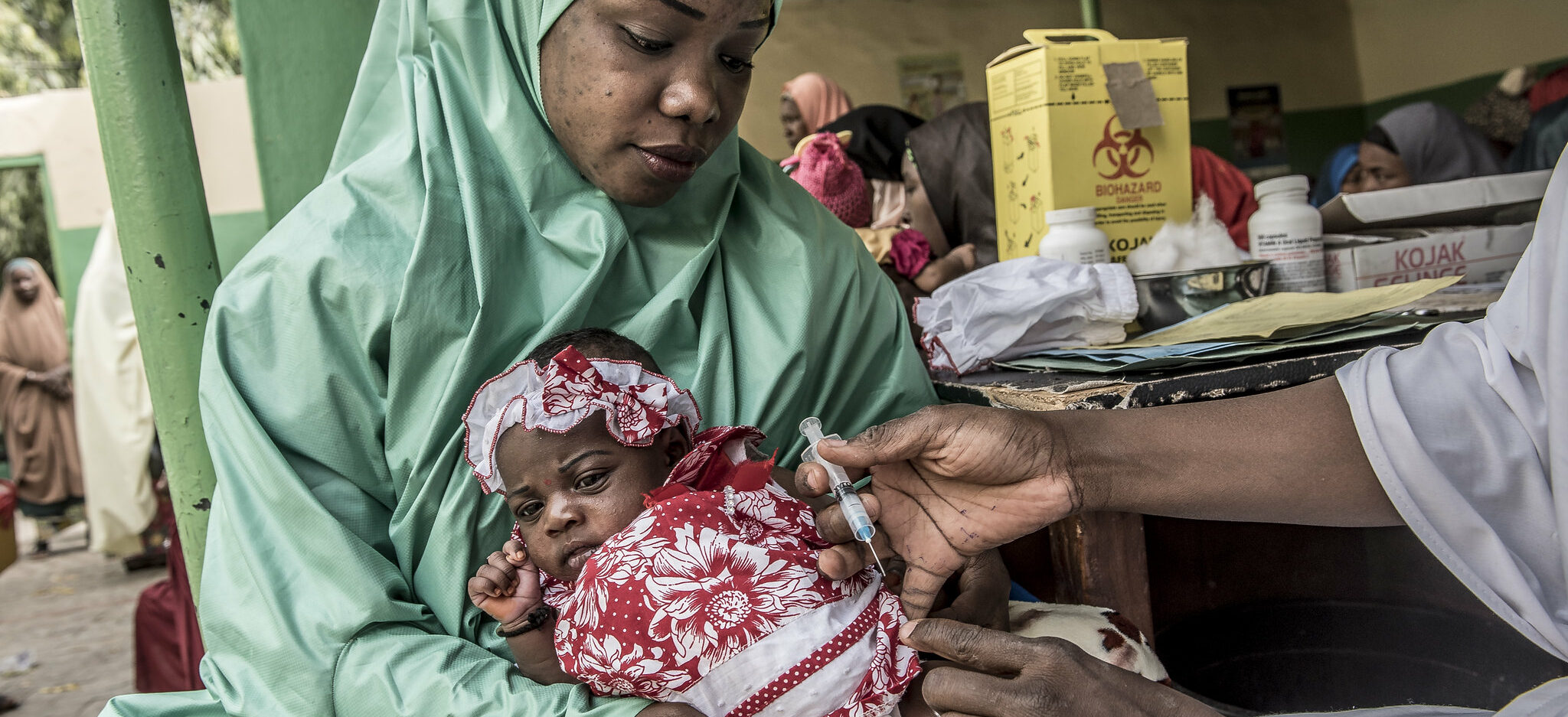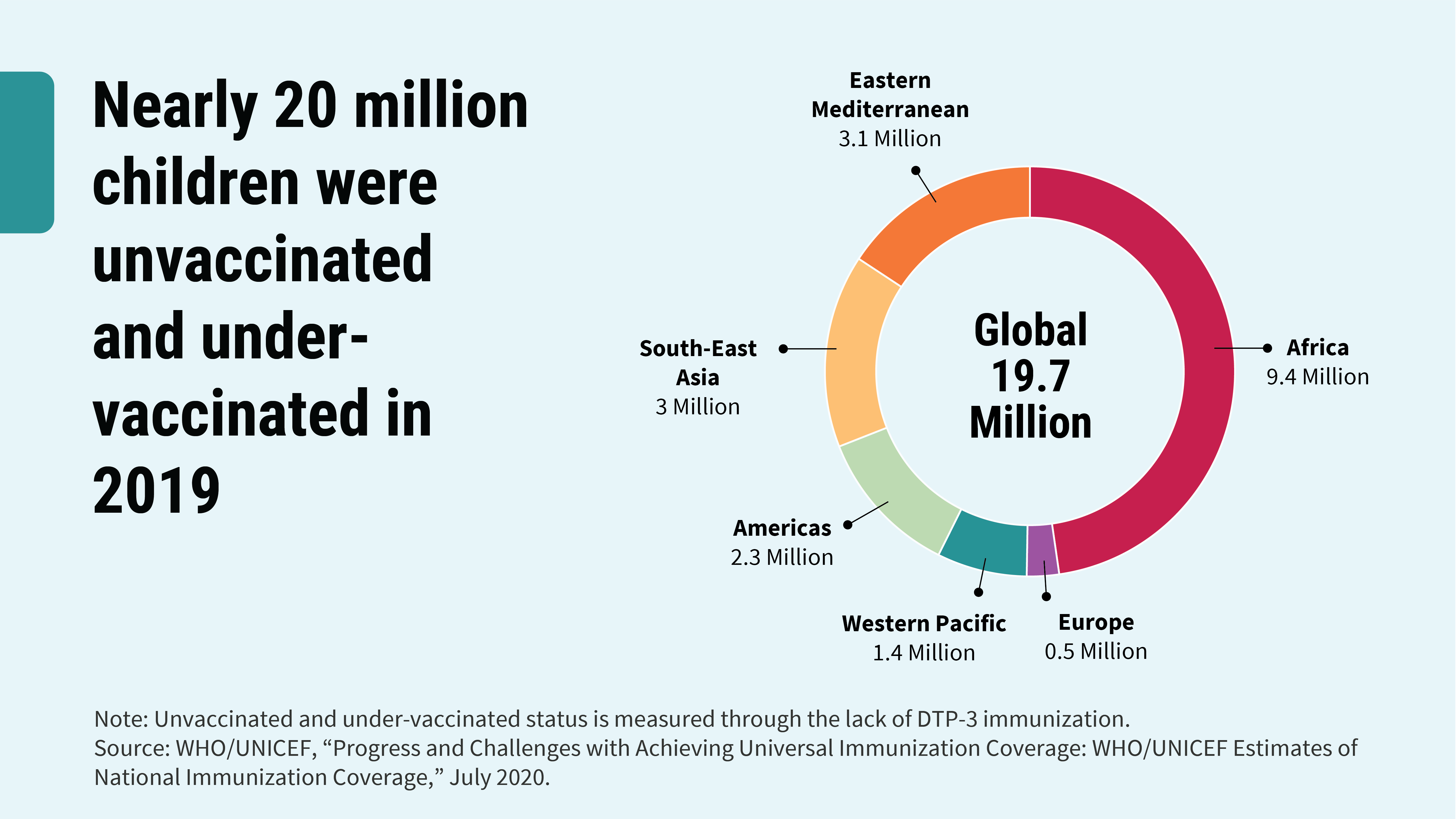Leave No One Behind: How Can We Reach Every Child with Life-saving Vaccines?
Published on April 10, 2021

Amid the COVID-19 pandemic, the eyes of the world are on vaccines and vaccination as never before. The pandemic has made clear to health officials, world leaders, and individuals that far too many people still lack access to life-saving vaccines. Immunization saves millions of lives every year and is widely recognized as one of the world’s most successful health interventions.1 Yet, for the past decade, childhood vaccination coverage rates have plateaued to about 85 percent2,3 leaving millions of children vulnerable to life-threatening diseases that vaccines can prevent. This plateau puts the world off track towards its goal to provide access to safe and effective medicines and vaccines for all, as outlined in the World Health Organization’s Immunization Agenda 2030 and the United Nations’ 2030 Agenda for Sustainable Development.4
MOMENTUM recognizes that access, quality, and equity of routine immunization are persistent issues that remain regardless of whether we live in a global pandemic. That’s why we’re working to increase investment in vaccines, making sure routine immunizations remain a priority so that children don’t miss out on getting the vital vaccines they need.
Who are we not reaching with vaccination?
In 2019, an estimated 14 million children were “zero-dose,” meaning they had not received even a single dose of the vaccines that prevent diphtheria, tetanus, pertussis, and other life-threatening and debilitating diseases. An additional 6 million children were under-immunized, having started but not completed their vaccination schedule and therefore only partially protected against these vaccine-preventable diseases.5
Roughly two-thirds of zero-dose children live in just 10 countries, including several (the Democratic Republic of the Congo, Ethiopia, India, Indonesia, Nigeria, and Pakistan) that are a high priority for USAID.6 The reasons for their zero-dose status are complex and interrelated. Factors such as living in remote, rural areas, rapidly growing cities, or fragile, insecure settings are worsened by low social and economic status, gender-related barriers, and under-resourced health systems. These are the settings where MOMENTUM is collaborating closely with ministries of health and local partners to amplify immunization efforts and help build capacity to analyze and address why children are zero-dose and develop innovative solutions to reach them better.
Why is it important to reach zero-dose children?
Reaching these children with immunization not only protects them from illness and death and increases their chances for a healthy, productive life, it also generates broader health benefits.
Closing immunity gaps reduces disease outbreaks and health system disruptions.
Communities with large numbers of zero-dose and under-immunized children are at high risk of outbreaks of contagious diseases such as measles. Between 2016 and 2019, measles cases increased by 50 percent, with almost 870,000 cases reported globally—the highest number in 23 years—and over 207,000 estimated deaths from this vaccine-preventable disease.7 Measles suppresses the immune system, leaving children vulnerable to other common infections and placing more pressure on health systems. MOMENTUM helps countries to provide continuous, high-quality, timely vaccination services to zero-dose and under-immunized children.

Reaching zero-dose children can increase their contact with the health system for other types of care.
A zero-dose child is unlikely to receive other essential health care services such as well-child care or proper management of acute and chronic illness. In some communities, outreach services for immunization may be the family’s only contact with the health system, creating an opportunity to provide additional services such as vitamin A supplementation, insecticide-treated bed net distribution, and pregnancy advice.8,9
In some countries, the microplanning process used in immunization to identify and reach children with vaccines has been adapted to improve postnatal and child health care planning.10 Identifying and reaching zero-dose children can contribute to the scale-up of high-quality maternal, newborn, and child health services, voluntary family planning, and reproductive health care for all communities.
How does MOMENTUM help reach zero-dose children?
Reaching zero-dose children requires tailored, creative approaches that strengthen systems and build partnerships across a broad range of stakeholders. MOMENTUM works with national and local health systems to diagnose obstacles to equitable coverage and respond in a variety of ways, depending on the needs, including:
- Identifying and mitigating gender-related barriers that limit caregivers’ knowledge of when, where, and why to seek immunization services and improving the timing and location of services to better meet their needs;11
- Strengthening immunization supply chains to reduce stockouts of vaccines and increase their availability to all communities through improved forecasting and better vaccine stock management;
- Forging community and health system partnerships to identify why some children are not vaccinated and jointly plan and monitor the services provided to them;
- Engaging local leaders to promote the importance of immunization and help find local solutions to immunization service barriers; and
- Supporting national and sub-national planning and budgeting and mobilize local resources to reach zero-dose children.
Routine immunization for children delivers a lifetime of health ‘earnings.’ We recognize that vaccinated children grow into healthy adults who can go to school, participate in the workforce, and support their communities. Moving forward, MOMENTUM will join global efforts in promoting the importance of vaccination in bringing people together and improving the health and well-being of everyone, everywhere.
MOMENTUM Routine Immunization Transformation and Equity focuses on the sustainable strengthening of routine immunization programs to overcome the obstacles contributing to declining immunization rates and address the barriers to reaching zero-dose and under-immunized children with life-saving vaccines and other health services.
MOMENTUM Country and Global Leadership works in tandem with country governments and local nongovernmental organizations to provide targeted technical and capacity development assistance and contribute to the global technical leadership and policy dialogue on improving measurable outcomes for maternal, newborn, and child health; voluntary family planning; and reproductive health care.
Immunization
Strong routine immunization systems can stop the spread of preventable infectious diseases and support national security and economic prosperity. We strengthen country immunization programs as a central approach to reducing newborn and child deaths in USAID partner countries.
References
- Gavi. 2020. “Value of Vaccination.” Accessed March 23, 2021. https://www.gavi.org/vaccineswork/value-vaccination.
- Gavi. 2020. “Value of Vaccination.” Accessed March 23, 2021. https://www.gavi.org/vaccineswork/value-vaccination.
- World Health Organization. Immunization coverage. Fact Sheet. July 15, 2020. https://www.who.int/news-room/fact-sheets/detail/immunization-coverage.
- United Nations. “Goal 3: Ensure healthy lives and promote well-bring for all at all ages.” Accessed March 16, 2021. https://www.un.org/sustainabledevelopment/health/.
- World Health Organization. Weekly epidemiological record. November 13, 2020. https://apps.who.int/iris/bitstream/handle/10665/336590/WER9546-eng-fre.pdf?ua=1.
- World Health Organization and UNICEF. Immunization coverage: Are we losing ground? July 2020. https://data.unicef.org/resources/immunization-coverage-are-we-losing-ground/.
- World Health Organization. Worldwide measles deaths climb 50% from 2016 to 2019 claiming over 207 500 lives in 2019. News release. November 12, 2020. https://www.who.int/news/item/12-11-2020-worldwide-measles-deaths-climb-50-from-2016-to-2019-claiming-over-207-500-lives-in-2019.
- World Health Organization. 2018. Working Together: an integration resource guide for immunization services throughout the life course. Geneva: World Health Organization. https://apps.who.int/iris/bitstream/handle/10665/276546/9789241514736-eng.pdf?ua=1.
- Guignard, Adrienne, Nicolas Praet, Viviane Jusot, Marina Bakker, and Laurence Baril. 2019. “Introducing new vaccines in low- and middle-income countries: challenges and approaches.” Expert Review of Vaccines. 18, no. 2 (February): 119–131. https://doi.org/10.1080/14760584.2019.1574224.
- Maternal and Child Survival Program. Exploring the Adaptation of the RED/REC approach to Other RMNCH Areas in Haiti, Kenya, and Uganda. October 2019. https://www.mcsprogram.org/resource/exploring-the-adaptation-of-the-red-rec-approach-to-other-rmnch-areas-in-haiti-kenya-and-uganda/
- Gavi. 2020. “Gender and immunisation.” Accessed March 17, 2021. https://www.gavi.org/our-alliance/strategy/gender-and-immunisation.

